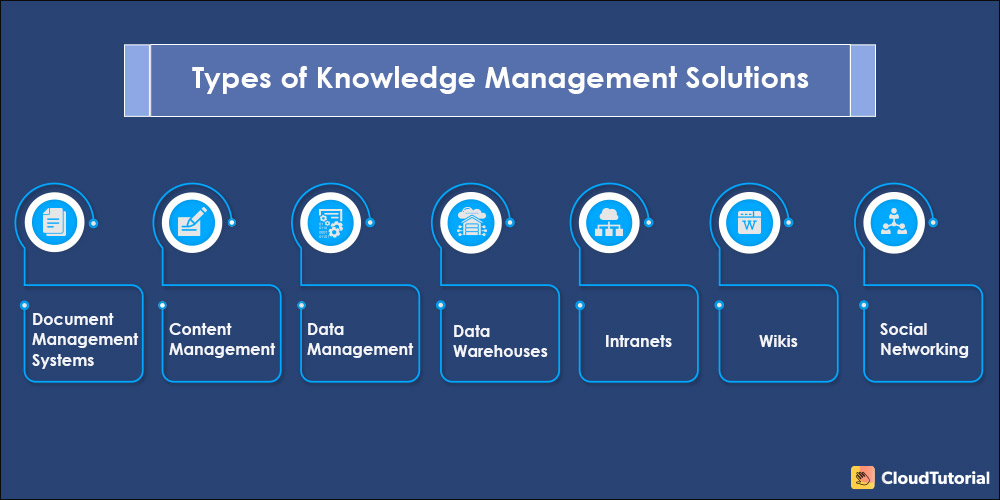Data is an organization’s most valuable asset. Data continually expands in volume, but that doesn’t mean it is growing in value too. For that, data needs to be correctly obtained, stored securely, and should be clean and surfaced. It is only after that the data can get used meaningfully.
Companies are constantly looking for ways to transition from information management to knowledge management systems. But are these two systems different from each other? Can we utilize any part of information management to implement knowledge management efficiently?
This blog aims to answer this and other questions about information and knowledge management.
Table of Content
What is Information Management?
Collecting, managing, and information sharing is called information management.
Data has many different origins and comes in various formats. Such information gets stored securely in an organized and structured way.
They fulfill the relevant regulations and policies and are also accessible to authorized employees.
Information governance is necessary to handle information management.
What is Knowledge Management?
Data is beneficial only when it brings value to the company. The bits and bytes have to be converted into information to become a helpful intellectual capital. That’s where knowledge management km steps into the picture.
Knowledge management is the process of capturing, distributing, and efficiently using knowledge. It may sound similar to information management, but it is not the case.
Knowledge is a processed form of information and goes beyond the extracting of facts from the data. Knowledge creation is the refinement of information into something beneficial, while knowledge discovery focuses on information’s application.
Companies maintain both explicit and tacit knowledge. Together they create a knowledge base that acts as a key factor for a company’s competitive advantage.

Want to Efficiently Capture, Share, and Use Knowledge?
Adopt CloudTutorial, trusted by leading brands and startups, to get your knowledge management up and running in minutes.
What are Types of Knowledge Management?
Explicit, Tacit, and Implicit are the different types of knowledge management.
Explicit Knowledge
Explicit knowledge is a basic form of knowledge. It can be written down and is accessible. Hence, it is easy to pass along. When data gets processed, organized, structured, and interpreted, it is called Explicit knowledge.
Explicit knowledge can be articulated, recorded, communicated, and stored without any hassle.
Company data sheets, white papers, and research reports are examples of explicit knowledge.
Tacit Knowledge
Tacit knowledge comes from personal experience. It is the data that is difficult to write down, articulate, or present in a tangible form. Here are some examples of tacit knowledge:
- Knowing the precise words to use within your content to attract and engage your readers.
- Identifying the right moment a client is ready to hear your sales pitch.
- Understanding which specific piece of content to deliver based on the expressed needs.
Implicit Knowledge
It is the practical application of explicit knowledge. Let’s say that you ask your co-worker how to perform a specific task. It will initiate a conversation about the available options to complete the job with their possible outcomes. All this leads to a thoughtful process of determining the best course of action.
It is your co-worker’s knowledge that starts the conversation. It covers everything from how to perform the specific task to its possible outcomes.
The best practices and skills, which are transferable are examples of implicit knowledge.
What are Some Examples of Knowledge Management Solutions?

Sharing information throughout the organization gets more effortless with reliable knowledge management programs. It will fulfill your every need, both at the departmental and company-wide levels.
Knowledge management software’s purpose is to capture information. It will verify, organize, and make knowledge sharing and retrieving a seamless process.
Here are some excellent examples of knowledge management systems.
Document Management Systems
These are centralized digital filing cabinets for business documents. It makes it easy for you to retrieve any of your documents. Document management fully meets relevant regulations and enhances the workflow.
You can add passwords and backup procedures to improve your document security. Although, many document management systems have functionality limitations. Hence, you will have to rely on custom upgrades, which will be costly.
This type of system does not capture data automatically or analyze it.
Content Management
Content management systems store audio, video, and other media types in addition to documents. They are considerably similar to document management systems.
Data Management
The database allows users to capture, store, analyze, and interact with the data. They get indexed for better accessibility to information and knowledge.
Collected data in databases are secured, and it is not possible to manipulate them. But, they may be volatile and costly to design and set up.
Databases demand high skills for usage and maintenance.
Data Warehouses
Data warehouses hard data from various parts of the company. It is a highly effective km system for reporting and analysis.
Data warehouses store every data, both current and old ones. They transform these data into meaningful information and knowledge.
Such km systems require high maintenance. Integrating them is a complex process if companies want to provide a unified view of data.
Intranets
Intranets are private computer networks. It will provide access to knowledge, which will help you improve collaboration and social networking in your company.
Although, an intranet can easily get accessed by an unauthorized person. They are also very time-consuming and costly to maintain.
Wikis
Wikis are web pages that allow anyone to publish and store information in a central location. Corporate wiki is a good place for storing and maintaining product catalogs and business documents.
Anyone can edit a wiki. Hence, it might contain wrong information. Wiki’s aren’t optimized to show what information is getting viewed or used. It may even have knowledge gaps.
Social Networking
Social networking enables employees to connect, join groups, contribute information, and discuss whatever interests them. It will influence your organizational knowledge. Knowledge management systems can use social networking to identify, document, and transfer knowledge.
What is the Difference Between Information Management and Knowledge Management?
The difference between knowledge management and information is that one focuses on users while the latter focuses on business processes.
Information management focuses on hard data, while knowledge management includes opinions and intuitions of people.
Here are some essential differences between knowledge management and information.
| Knowledge Management | Information Management |
|---|---|
| Knowledge management includes every aspect of the enterprise, such as communication, management frameworks, organizational culture, and organizational structures. | Information management focuses on the explicit aspect of information, such as facts, figures, and other hard data. |
| Knowledge management gets measured by changes in the work and behavior of individual employees and teams over time. | Information systems can get measured quantitatively in short time frames. |
| Knowledge management ushers innovations that are unique to a company. It does this by creating km tools, platforms, and processes for Tacit knowledge creation, sharing, which companies can use to their advantage. It ensures that Tacit knowledge becomes explicit. | Information systems are easy to replicate. Information management helps dictate how companies form strategies and implement processes based on them. |
| Knowledge management uses discrete data to address issues. Companies can use the data to help the employees make well-informed decisions and undertake problem-solving actions. | Information management is technology-based. It deals with raw data and how to manage and process it in systems to solve problems that the company is facing. Also, create new opportunities. |
Information management and knowledge are different in terms of purpose and scope. But, both have significant benefits for organizations.
It is essential to classify and categorize the data and knowledge. Doing this will ensure that it’s discoverable and retrievable. Also, it will simultaneously maintain security and regulatory compliance.

Want to Create an Online Knowledge Base in Minutes?
Cloudtutorial will help you share knowledge amongst employees so efficient work is guranteed!
- Enterprise-wide KMS
- Knowledge work system
Conclusion
Is your company looking to transition from information management to knowledge management? CloudTutorial, a knowledge management software, makes the entire transition a very seamless process. Develop your intellectual capital with this effective knowledge management software and gain a competitive advantage.
With the help of this software, you can improve the efficiency of your company’s operating units and various processes. CloudTutorial will help you achieve both employee and customer satisfaction. So what are you waiting for? Just schedule a 14-day free trial today!!
Try it out before you decide.
Create a test article NOW!
Using this tool, all you have to do is add your first test article and see how it looks. Now, you don’t have to sign-up or login into CloudTutorial software just to check how your first article appears.

